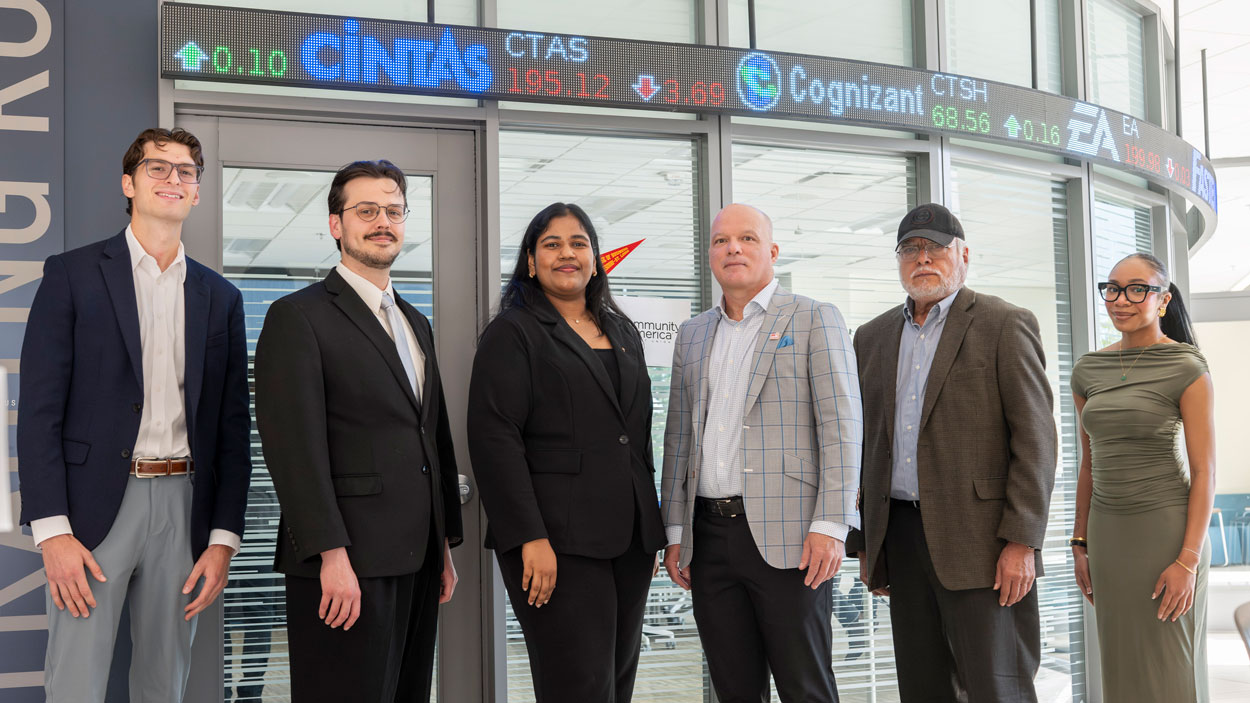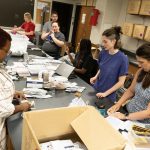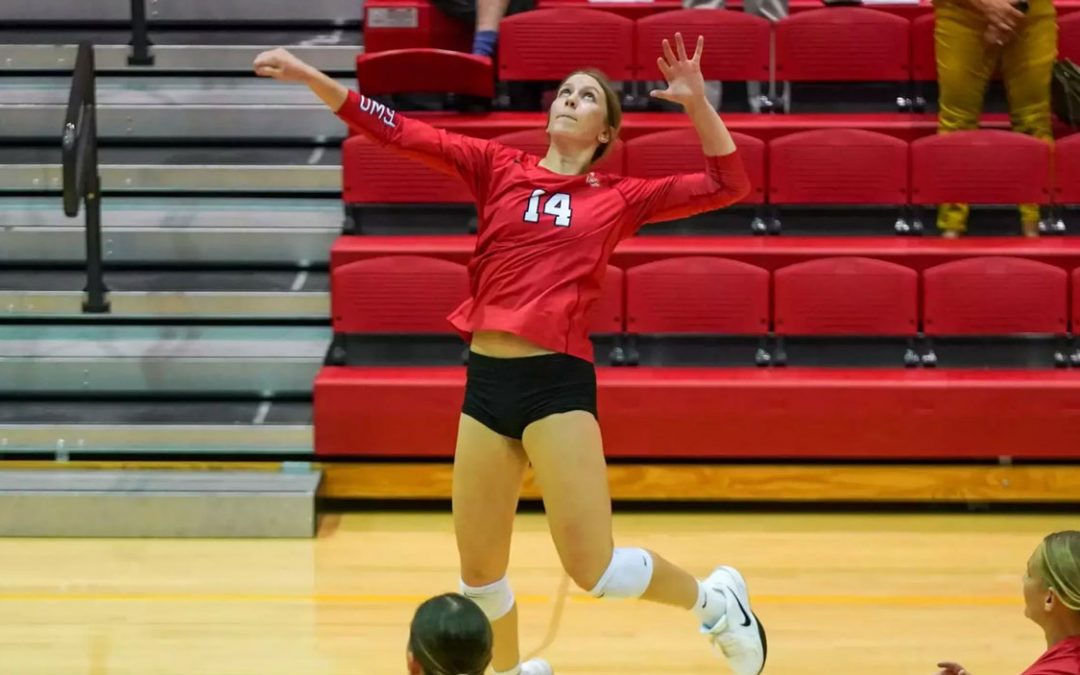
The Student Investment Trust recently eclipsed $1 million in portfolio value. Helping the fund reach that height include (from left) club president Mike Clark, Julian Barnes, Anisha Inaganti, faculty advisor David Beverly, Octavio Medina and Bree Mitchell. (Photo by Derik Holtmann)
Back in 1988, faculty members and alumni cobbled together $8,800 to create a fund that would offer University of Missouri–St. Louis students a chance to learn investment strategies and methodologies by investing real money in the actual stock market, as opposed to relying on theoretical exercises to gain experience.
That same Student Investment Trust just eclipsed $1 million in value, checking in at $1,003,852 when David Beverly, the faculty advisor for the student organization and an assistant teaching professor of finance, looked at the account with Northern Trust on the morning of Oct. 7. When Beverly took over as faculty advisor for the club in 2023, the fund was right around $580,000.
“It’s done well in the past few years,” Beverly said. “The students are the ones making the trades, and I just facilitate it. We definitely didn’t expect to almost double in two years. That’s a pretty large growth, but we take what the market gives us. We can’t act like the gains are all our doing, because then when it goes the other way, we’re not going to take all the blame. We’re taking what the market gives us, and we’re trying to enhance a small part of it. And we’ve done a little bit better than the market over the last two years, but the market’s done really well.”
In his first year as faculty advisor, a large portion of the club’s time was dedicated to having students run different portfolio analyses and then make recommendations on what they thought the group should remove or add to the portfolio, which is comprised of roughly 65 stocks. With a large portion of the portfolio made up of large-cap blue-chip stocks, including companies like Costco and Walmart, there wasn’t much of a reason to make sweeping changes.
“It was a good exercise,” Beverly said, “but it wasn’t as entertaining and engaging as picking your own companies and trading your companies.”
Starting with the spring semester, Beverly took a bit of a different approach, separating the club’s roughly 30 members into groups based on their interests, giving students an opportunity to learn a variety of trading philosophies. He allocated roughly $25,000 to each group. When the students make their decisions, they have to explain their rationale to the other students in the club, and then Beverly executes the trades during class.
Defending their choices is part of the student experience the club provides.
“That’s beneficial for both sides,” said Bree Mitchell, a master’s student studying fintech. “For the people listening, it’s essentially like a lecture environment where you can learn what others are doing. But for the people who are presenting, it shows the gaps in knowledge you don’t fully understand. Maybe intrinsically you know what’s going on, but if you can’t explain it to someone, then you have to figure out how to fully explain it.”
The groups are:
The value group: This group of students looks for specific value indicators in stocks – fundamentally strong companies with a relatively low price – and are traditionally longer-term plays.
The technical analysis group: This group tries to recognize patterns and capitalize on stocks that follow those patterns. This is typically the approach of day traders, though the SIT only meets and trades once per week, so Beverly teaches students to identify weekly, not daily, patterns.
The algorithmic group: Beverly gave this group of students a basic algorithm to use, and the students modified the algorithm a bit, with great success. This group has outperformed the other two over the past year and was the only group to make money last semester (even though the other two groups still beat market averages).
The “secret” group: For this one, which is new for the fall semester, Beverly is using AI products – provided with the same parameters as the student groups – to make trades. He’s keeping the results secret until the end of the semester, when the results will be compared to the students’ results.
When Mitchell first talked with Beverly about joining the group at the beginning of the spring semester, she told him that she was interested in learning more about algorithmic trading. And it just so happened that Beverly was looking to start the algorithmic group, so the match was ideal. As with the others in that group, Mitchell was new to the concept.
The basic algorithm the group worked off included a graph that displayed both the 50-day and the 200-day performance for stocks; when the 50-day line was above the 200-day line, that was a potential buy. When it was under the 200-day line, it was a potential sell. After studying the setup, the students added the RSI – relative strength index – to the mix to feel more confident in their decision-making process.
That algorithm, combined with Mitchell’s personal knowledge and interests, produced one of the most profitable stock buys in club history: D-Wave Quantum, Inc.
“When I pick my stocks to trade, I try to stay within industries that I am familiar with,” Mitchell said. “I’m interested in quantum computing, and I loosely keep up with what’s going on in that industry. Around that time, I had read news that there would be significant advancements in chips for quantum computers being made, so I thought that would be good for the industry. I went through my stock screener, trying to find some cheap quantum computing stocks that have been doing pretty well for the last three to five months, and D-Wave Quantum was one of them. I ran that through our algorithm, and it confirmed that it was a good stock. It was a buy.”
At the time the Student Investment Trust purchased 688 shares of D-Wave Quantum on April 11, on Mitchell’s recommendation, the stock was at $7.24. It closed at $35.72 on Oct. 7, which is a profit of roughly $19,000.
“I remember when it first really jumped up, at some point in late May,” Mitchell said. “I have our stocks on an app on my phone to keep track of whether they go up or not. I woke up one day and looked and saw that that one specifically had gone up like 55%. It was crazy.”
From there, D-Wave held in the $14 to $20 range through mid-September, when it jumped up into the mid-$20s, and then it shot past $30 in October. Typically, Beverly will sell stocks bought during the semester at the end of the semester – while holding on to the long-term portfolio drivers such as Costco and Walmart – so the next group can start with a fresh slate. With D-Wave Quantum, though, he recognized the value of Mitchell’s find and held on to the shares.
“It looked like a really solid company, so we kept it in the portfolio,” Beverly said. “That was one of the bigger ones that has driven the growth over the last few months.”
Beverly said he’s been impressed with the students in the club and would like to see its growth mimic that of the Student Investment Trust. The club meets on Thursday at 12:30 p.m. in Room 108 of Anheuser-Busch Hall.
“It’s open to everybody in the university,” he said. “I was sitting in on a class this weekend with some of our DBA students, and they were interested. They should absolutely come and sit down, and we will hopefully help them out in some way, whether it’s just knowing what questions to ask their advisor or gaining a little bit better understanding of what they’re seeing in their reports. We welcome everybody.”














